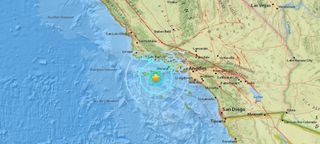A 5.3-Magnitude Earthquake Just Struck Southern California

An earthquake of preliminary magnitude 5.3 struck 38 miles (61 kilometers) off the coast of California Thursday afternoon (April 5), rattling Los Angeles.
That's a moderate quake in the grand scheme of things, and common enough in the region of the San Andreas fault, where LA sits. But the event was still dramatic enough to make people sit up and take notice. Several Twitter users took to the platform to ask if others had felt the quake. [What Causes Earthquakes?]
"This is a very interesting earthquake," Mark Legg, founder of the consulting firm Legg Geophysical, Inc., in Huntington Beach, California, told Live Science, adding that he's been anticipating such an earthquake, as a magnitude-5-plus temblor occurs there about every six years. The last one, a magnitude-6.3, struck in December 2012, he said.
The earthquake occurred near a complex region of several faults called the East Santa Cruz Basin fault zone, Legg said. These fissures in the Pacific Plate are located offshore around the Channel Islands; they were most active during the Miocene epoch (between about 20 million and 5 million years ago), Legg said, though they still produce earthquakes today. That's because they sit snugly on the Pacific Plate, whose motion toward Alaska is impeded by a bend in the San Andreas Fault and the Western Transverse mountain ranges, "which block the smooth northwest movement of the Pacific Plate," Legg said.
(The San Andreas Fault, which marks the boundary between the Pacific and North American tectonic plates, is not a straight line, but rather has lots of bends and other "cricks" along its path.)
Today's earthquake seems to have struck at a spot where a major collision is occurring along a boundary between the Western Transverse Ranges and what is called the California Continental Borderland.
"Sometimes, there are thrust earthquakes along this boundary, other times there are strike-slip earthquakes as the WTR [Western Transverse Ranges] tries to 'escape' around the bend in the San Andreas fault, as the Pacific plate moves to the northwest," Legg wrote in an email.
Sign up for the Live Science daily newsletter now
Get the world’s most fascinating discoveries delivered straight to your inbox.
A thrust-type quake happens when the earth on one side of a fault jumps upward and over the other side; a strike-slip earthquake means both sides of the fault move mostly horizontally, as happens along the San Andreas Fault.
If this all sounds complicated, don't worry, it is.
"I like to think of the southern California region as a major crustal 'Shear Zone' composed of many faults working together (or against each other sometimes) to enable the Pacific Plate to move on its way to Alaska," Legg said. "It is not a simple process, and that is what makes it extremely interesting to scientists like myself and many others.
The LA region experiences an earthquake of this magnitude about once a year,
There's a 1-in-20 chance that today's temblor will be followed by a larger quake in the coming weeks, said John Vidale, director of the Southern California Earthquake Center at USC, as reported by the Los Angeles Times. He added that the more likely scenario involves a series of much smaller aftershocks that may be too weak for anyone to even notice.
"There is a slight chance that this is a foreshock, but as time passes, that probability diminishes rapidly," Legg said.
There are no reports at this time of any significant damage from the quake, and there may not be any in a region well-prepared for temblors.
Live Science's Jeanna Bryner contributed reporting to this article.
Editor's Note: This article was updated this evening with more information about the earthquake.
Originally published on Live Science.


